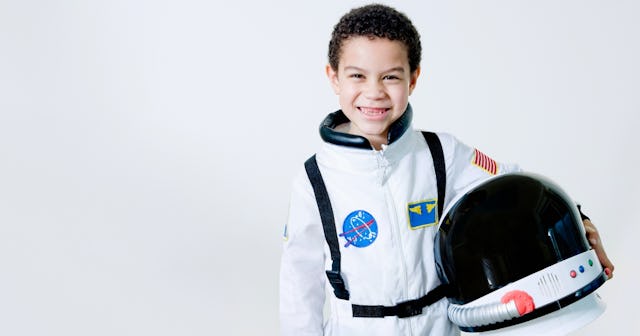11 NASA Coloring Pages That'll Send Your Space-Obsessed Kid Into The Stratosphere

If you’re space nerds like us (and considering you’re here, it’s a solid assumption), you probably think NASA is the pinnacle of cool. Seriously, did anyone not dream of growing up one day to work there? And now, thanks to family-friendly movies like Hidden Figures and The Martian, younger generations get to see just how fascinating this space-centered organization is. So, you definitely want to foster that interest in your kiddos! Well, we’ve got just the DIY activity for you: NASA coloring pages.
No matter where your little one is in their learning journey, these free — yes, free! — printables are sure to be a hit. If they’re still learning their way around crayons, they’ll enjoy testing their skills on NASA satellites. For elementary-aged kids, the pages can serve as a launching pad for a more dimensional discussion about science, the galaxy, and beyond.
As if all of that wasn’t stellar enough, the atmospheric fun doesn’t have to stop with our NASA coloring pages. We also have solar system coloring pages, rocket coloring pages, astronaut coloring pages, and even alien coloring pages (why not, right?).
Free Printable NASA Coloring Pages
NASA Page No. 1
Have you ever wondered how NASA communicates with spacecraft? Your answer’s right here! NASA spacecraft exploring the solar system send information and photos back to Earth using what’s known as the Deep Space Network (DSN), a collection of giant radio antennas like the one pictured here. The crew of the first moon landing included Neil Armstrong, Buzz Aldrin, and Michael Collins. And fun fact: Crewmember’s urine is filtered into their water supply so they never go thirsty.
NASA Page No. 2
Not only are NASA rovers pretty darn cute, but they’re also instrumental to space exploration. Over the years, NASA has sent five of these robotic vehicles to Mars. Their purpose? To seek signs of ancient life and collect samples of rock and regolith (AKA broken rock and soil) for a hopeful return to Earth. The latest touchdown took place on Feb. 18, 2021, with a rover named Perseverance. You can even check out the raw images it takes! But the rover isn’t the only toy NASA created. Lonnie Johnson worked for NASA for over a decade and invented the Super Soaker.
NASA Page No. 3
The more we know about the planet we live on, the better it is for everyone. That’s why NASA has a fleet of 18 Earth science missions in space. These satellites make observations about every aspect of life as it affects us here on planet Earth — from the air that we breathe to ocean topography. Fun fact: During the free time, many astronauts enjoy taking pictures of the earth, especially shots of their hometowns if they can.
NASA Page No. 4
Those “wings” on the satellite are solar panels, which supply power to run sensors, heating, cooling, and telemetry. They also provide power for the satellite’s propulsion. Back in 1958, the Vanguard 1 satellite became the first spacecraft to use solar panels. Did you know some astronauts describe the smell of space as a “metallic ionization type smell?” What an interesting description…
NASA Page No. 5
Satellites come in many different shapes and sizes, but there are two primary types of satellites where orbiting the Earth is concerned. “A geostationary satellite travels from west to east over the equator. It moves in the same direction and at the same rate Earth is spinning,” according to NASA, adding of the other type, “Polar-orbiting satellites travel in a north-south direction from pole to pole.”
NASA Page No. 6
Observatories are so awe-inspiring that you might think, Maybe one day I’ll build my own space observatory! And, hey, more power to you. But just a word of warning: Depending on how technologically advanced they are and their size, dome observatories can set you back anywhere from $50,000 to more than $500,000.
NASA Page No. 7
Encourage your kid to do some deep-thinking while they color this page. Are those asteroids in the background? Planets and stars? The reason satellites are such a vital part of NASA’s work is because they allow the organization to see into space better than terrestrial telescopes. So, ask your little budding astronaut what they think this satellite sees!
NASA Page No. 8
Do you know what makes us think that those dark circles are planets? NASA’s Kepler Mission, which the organization launched in 2009, has discovered over 2000 possible planets — and 1284 came from a single finding. It’s mind-blowing to ponder what’s out there beyond our limited scope. It’s actually incredibly hard to become an astronaut. In 2017, out of a pool of 18,353 candidates, only 12 were selected for the program. That’s a .065 percent acceptance rate!
NASA Page No. 9
We’ve all wondered at some point how satellites don’t crash into each other (or other spacecraft). The surprising answer? Sometimes they do! Collisions have historically been rare, but scientists expect the possibility to increase as more satellites get launched into space. And who said scientists don’t have a funny bone? NASA nicknamed two of their launched satellites, Tom and Jerry, after the classic cartoon.
NASA Page No. 10
As you wrap up these coloring pages, share with your little artists the following two essential facts about NASA. First, its acronym stands for National Aeronautics and Space Administration. And, second, their slogan is: “To explore the universe and search for life; to inspire the next generation of explorers, as only NASA can.”
NASA Page No. 11
Monkeys and dogs were usually sent into space during the early years of space travel. On Sept. 20, 1951, a monkey named Yorick and 11 mice boarded the Aerobee missile flight. He was considered the first monkey to survive flight on a spacecraft.
Click here to print all of the NASA coloring pages at once!
This article was originally published on